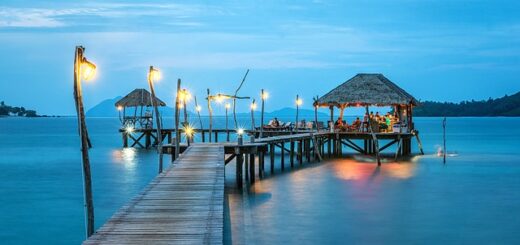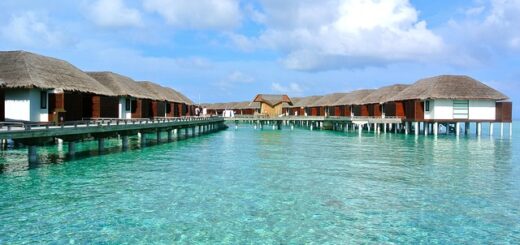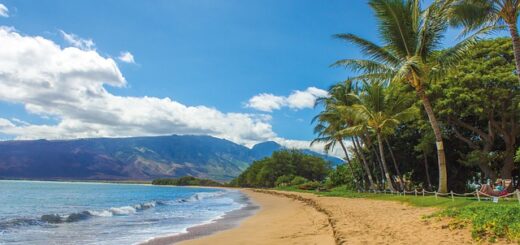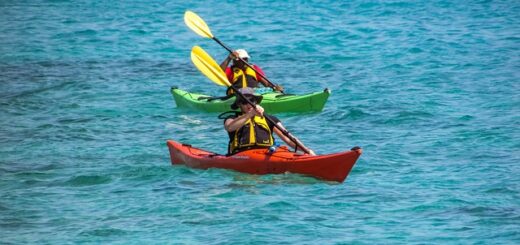Best Kite Surfing Destinations in the World
Kite surfing, an exciting water sport that combines elements of surfing, windsurfing, and wakeboarding, is popular worldwide. With its adrenaline-pumping rides, kite surfing offers an exhilarating experience for both beginners and experts.
We will explore the Best Kite Surfing Destinations in the world.
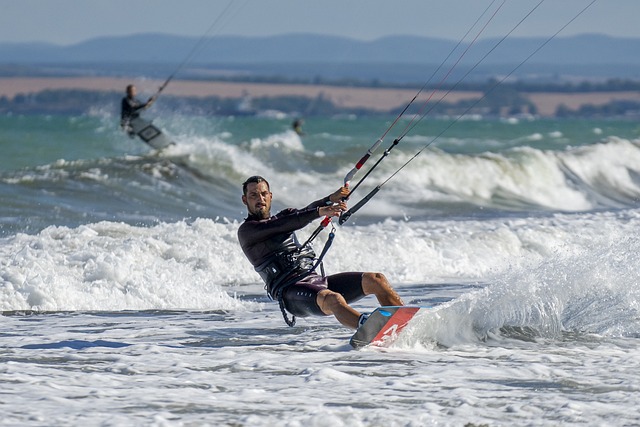
What is Kite Surfing?
Kite surfing involves using a large power kite to harness the wind’s power and propel a rider across the water surface on a small surfboard or a kiteboard. This exhilarating activity allows riders to glide, jump, and perform tricks, providing an adrenaline-filled experience on the waves.
Is Kite Surfing safe?
Kite surfing can be safe when practiced in the right conditions and with proper training. Learning from an experienced instructor and understanding weather and nautical conditions is essential. However, it can be dangerous if not adequately trained, leading to injuries such as back, neck, and limb pain, as well as fractures.
Best Kite Surfing places in the world
If you think about where to do Kite Surfing in the world, the following are the best places to do Kite Surfing.
Tarifa: Tarifa in Spain is one of the most exciting places to do Kite Surfing in world. On the southernmost tip of Europe, this charming coastal town offers a perfect blend of idyllic landscapes and ideal wind conditions that make it a mecca for kite surfers worldwide. With its world-class waves and consistent winds, Tarifa boasts several popular kitesurfing spots, including the Playa de los Lances, Playa de Dos Mares, and Playa de Valdevaqueros.
These locations provide ample space, clear waters, and breathtaking scenery, making Tarifa a top destination for both beginners and professionals in this exhilarating sport.
Maui: Maui in Hawaii is a surfer’s paradise that extends to kite surfing, making it one of the most popular destinations in the world. With its consistent trade winds and powerful waves, it offers an incredible wave-riding experience. Hookipa Beach Park and Kanaha Beach Park are renowned spots for both locals and visitors looking to challenge their skills. Also, check out our travel guide on the best beaches in Maui you must visit.
Essaouira: Essaouira, on the Atlantic coast of Morocco, is a hidden gem for kite surfers. With its consistent winds and wide sandy beaches, it’s a paradise for those seeking thrilling rides. The strong trade winds are ideal for experienced riders to enjoy wave riding. The charming medina, vibrant local culture, and delicious Moroccan cuisine add to the allure of this coastal town. Also, check out our travel guide on top things to do in Marrakech Morocco.
Cabarete: Cabarete in the Dominican Republic boasts excellent wind conditions throughout the year, attracting enthusiasts from around the globe. With its warm waters, consistent trade winds, and a lively beachfront lined with kite schools and shops, Cabarete offers a perfect blend of adventure and relaxation.
Zanzibar: Zanzibar in Tanzania, known for its white sand beaches and turquoise waters, offers a paradise-like setting for kite surfers. With reliable trade winds blowing almost year-round, this East African gem provides excellent conditions for both beginners and advanced riders. The unspoiled beauty of the island makes each session on the water a truly magical experience.
Cumbuco: Cumbuco in Brazil is one of the best kite surfing locations you must go to in the world. Cumbuco offers a perfect combination of wide, spacious beaches and ideal wind conditions that make it a paradise for kite surfers of all levels. Whether you are experienced, or a beginner, Cumbuco offers an unforgettable kitesurfing experience amidst breathtaking scenery and the thrill of riding waves on the vibrant coast of northeastern Brazil.
Kite Surfing tips
Take lessons: It is crucial to take lessons from a certified instructor before attempting to kite surf on your own. They will teach you the kite control basics, safety procedures, and proper technique. Lessons help you understand the wind conditions, equipment setup, and how to handle potential risks.
Choose the right equipment: Invest in quality gear that suits your skill level and the prevailing wind conditions. Beginners should opt for larger kites that offer more stability and forgiveness. The board should be appropriately sized for your weight and experience level. Consult with experts or instructors to find the perfect gear for you.
Learn self-rescue techniques: In case of an emergency, it’s important to know how to perform self-rescue maneuvers. It includes techniques like body dragging, where you use the power of the Kite to pull yourself toward shore if you lose your board or are unable to ride back. Practice these techniques regularly to build your confidence and ensure your safety.
Start in shallow water: When you’re ready to enter the water, start in shallow areas where you can easily touch the ground. It will allow you to focus on controlling the Kite and getting comfortable with the board without worrying about deep water or waves. Gradually progress to deeper waters as your skills improve.
Use safety gear: Safety should always be a priority. Wear a properly fitted helmet, impact vest, and a leash to keep you connected to your board. Consider using a quick-release harness system in case you need to detach from the Kite quickly.
Keep improving your skills: Kite surfing is a sport that requires continuous learning and improvement. Take advantage of advanced lessons, workshops, and clinics to enhance your skills and knowledge. Push your limits gradually and always prioritize safety over pushing boundaries.
Things to know before doing Kite Surfing
Safety: One of the most crucial aspects of kitesurfing is safety. Understanding and adhering to safety guidelines, wearing the necessary protective gear such as a helmet and life jacket, and being aware of your surroundings.
Learn from the Experts: Kitesurfing requires instruction and guidance from experienced instructors who can teach you the fundamentals and help you progress safely. Taking lessons will not only accelerate your learning but it will also provide you with valuable information about wind conditions, kite control, and water safety.
Wind Awareness: You need to learn about wind direction speed and Its effects on the Kite. Knowing how to identify a good wind for kiting is crucial, as strong winds can be dangerous for beginners. Familiarize yourself with the concept of the wind window, which is the three-dimensional area in which the Kite can fly.
Equipment Basics: Kitesurfing requires specialized equipment, including a kite, a control bar, lines, a harness, and a board. It’s important to learn about the different types of kites, their sizes, and their specific uses.
Physical Fitness and Swimming Skills: Before venturing into kitesurfing, it’s important to assess your physical fitness level and ensure that you have the necessary stamina and flexibility to handle the demands of the sport. Moreover, being able to swim is a prerequisite for kitesurfing, as you will be spending a significant amount of time in the water.
Kite Surfing myths you must know about
You need to be strong to kite surf: While physical strength can be an advantage, kite surfing is more about technique and skill than brute strength. Proper body positioning, kite control, and board control are key factors. With the right technique, riders can use the wind’s power efficiently, minimizing the physical effort required. Beginners can start with larger kites that offer better stability and easier handling.
Kite surfing is only for young and fit individuals: Kite surfing is open to people of all ages and fitness levels. As long as you have a reasonable level of fitness and are willing to learn, you can enjoy kite surfing. With proper instruction and equipment suited to your abilities, anyone can embark on this exciting adventure. It’s important to consult with instructors who can guide you toward gear appropriate for your age and physical condition.
Learning to kite surf takes a long time: While becoming an expert may take time and practice, learning the basics of kite surfing is achievable within a relatively short period. With proper lessons from certified instructors, beginners can quickly grasp kite control, safety procedures, and fundamental riding techniques.
You need waves to kite surf: kite surfing does not necessarily require waves. While riding waves can add an extra element of excitement, kite surfing can be equally thrilling on flat water surfaces such as lakes or lagoons. The primary source of power comes from the wind, which propels the Kite and allows riders to glide across the water surface.
Kite surfing is dangerous: Like any adventure sport, there are risks involved in kite surfing, but when practiced with proper training and adherence to safety protocols, the risks can be effectively minimized. Taking lessons from certified instructors, understanding weather conditions, using appropriate safety gear, and practicing self-rescue techniques enhance safety.
Kite surfing is only for warm climates: Kite surfing can be enjoyed in various climates and conditions. While warm tropical destinations are popular among kite surfers, the sport can also be pursued in cooler climates. Kite surfers can take advantage of strong winds in colder regions as well. With the right wetsuit or drysuit, thermal layers, and appropriate gear, kite surfers can comfortably ride in colder water temperatures.
Final Words
When it comes to the best kite surfing destinations in the world, there are plenty of incredible locations. From the perfect beaches of Maui to the remote beauty of Tarifa, Spain, these places offer the best kite surfing conditions and stunning scenery.
With the right knowledge and preparation, you can enjoy the thrill of kite surfing in these exciting locations around the world. So, pack your gear and head to these amazing destinations for an unforgettable kite surfing experience.



